
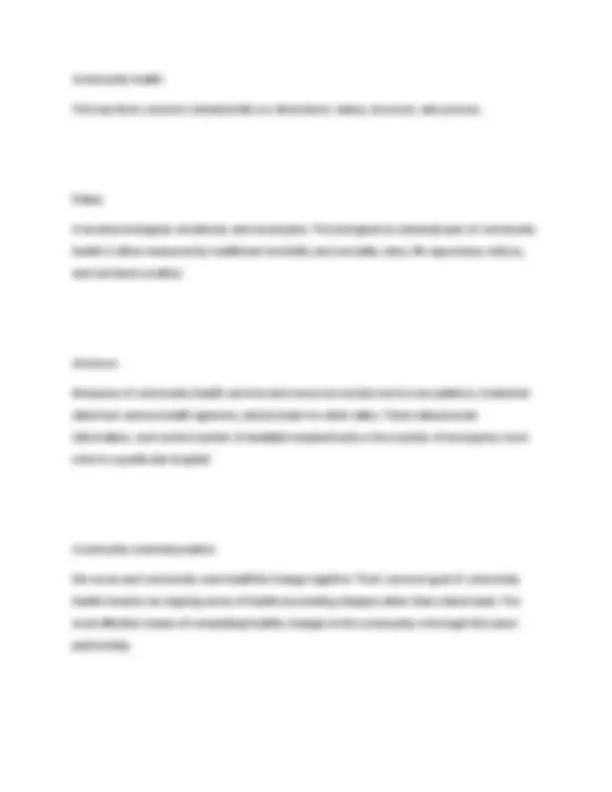
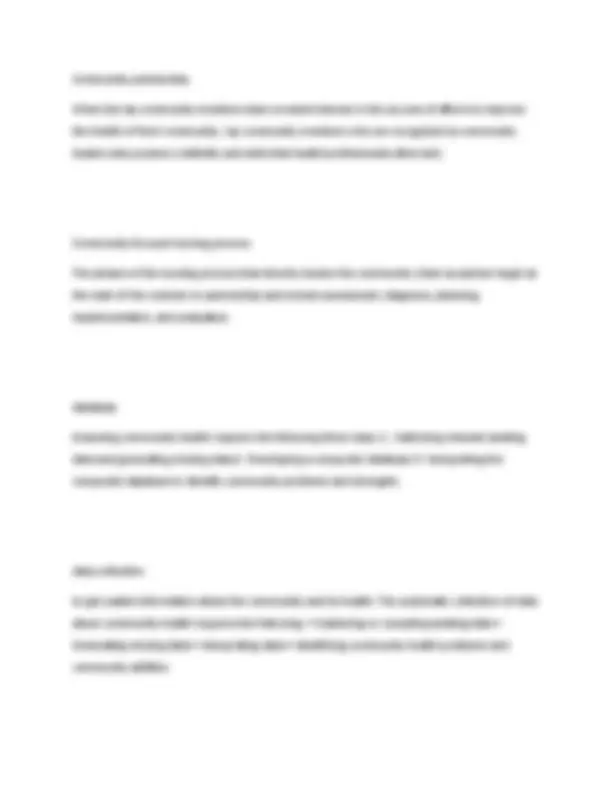
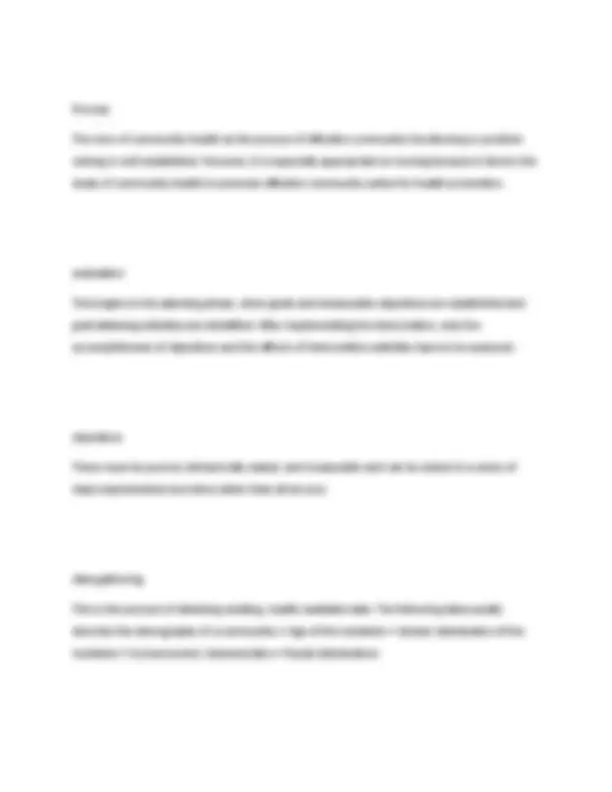
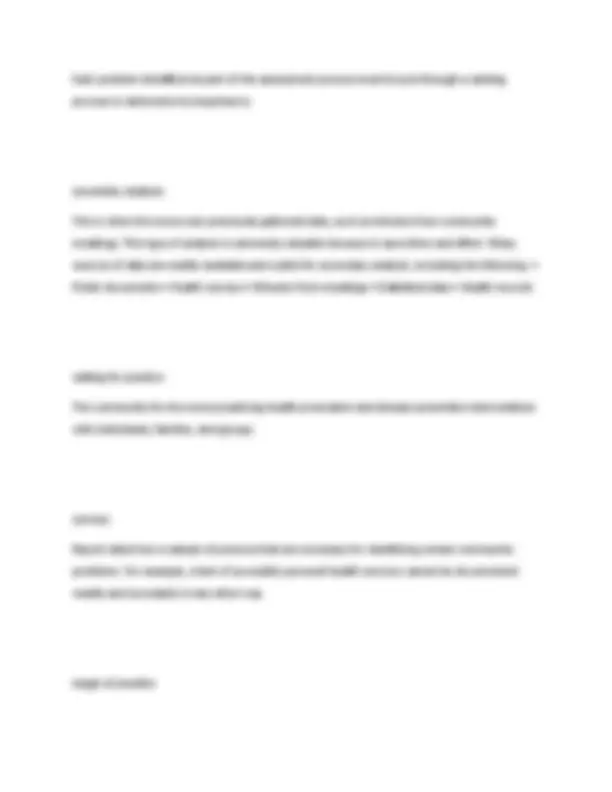
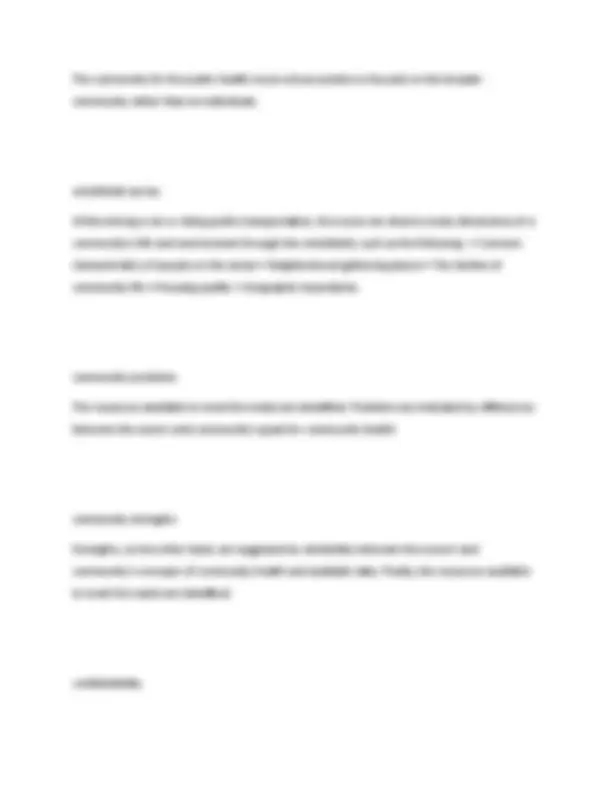
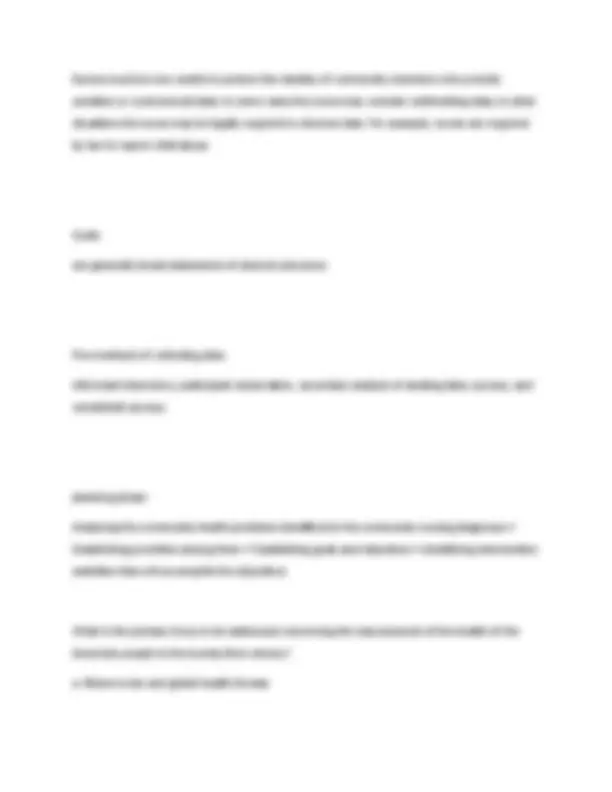
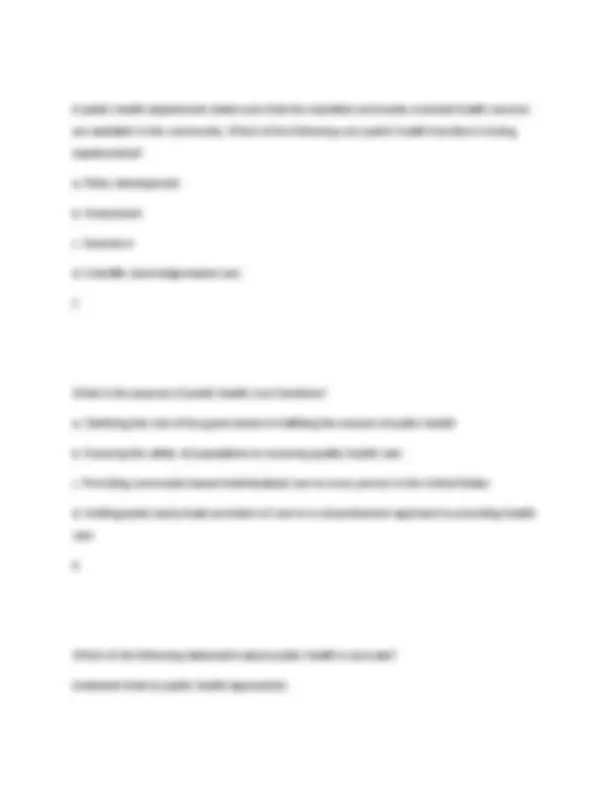
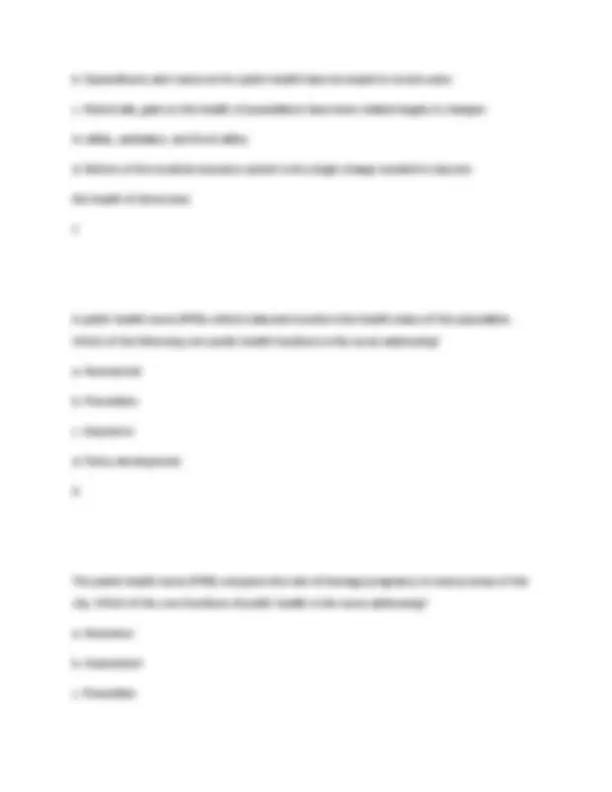
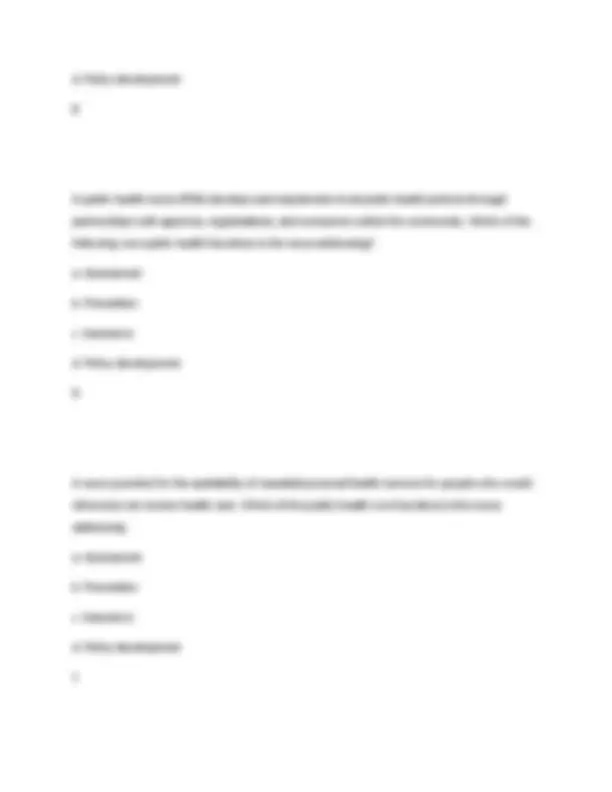
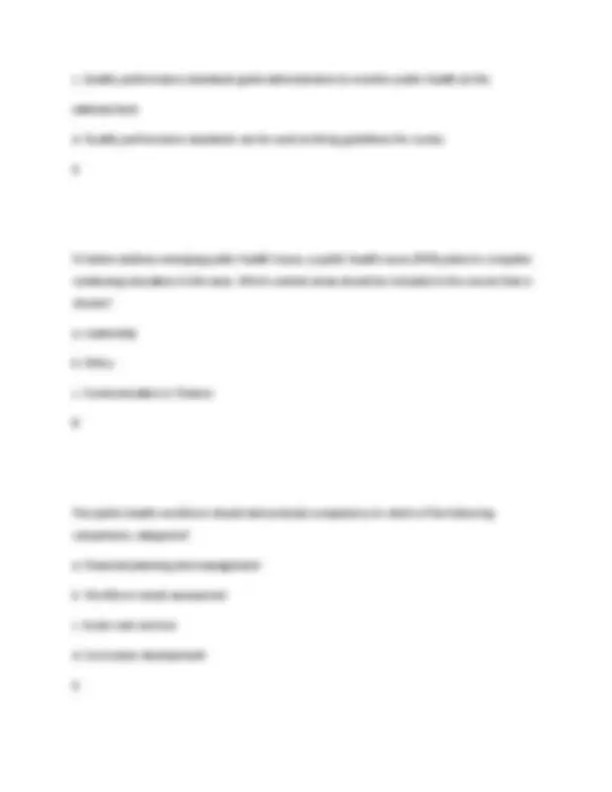
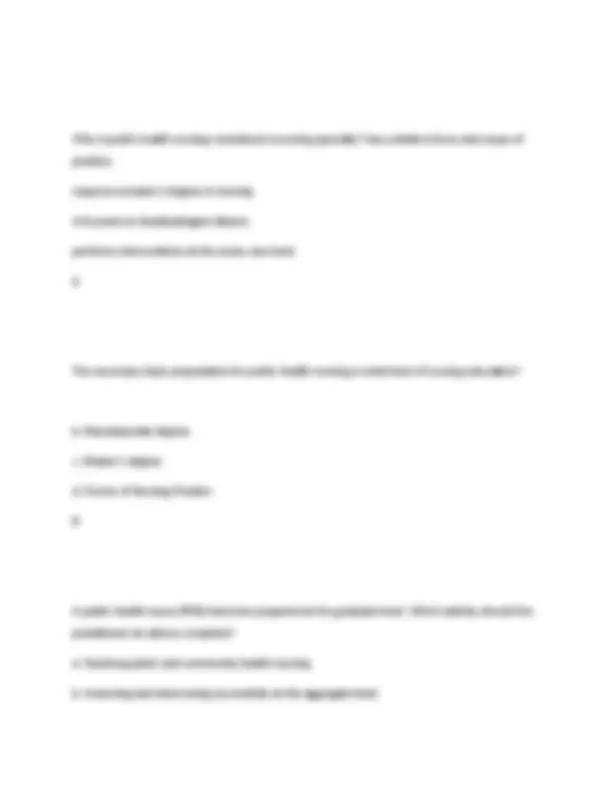
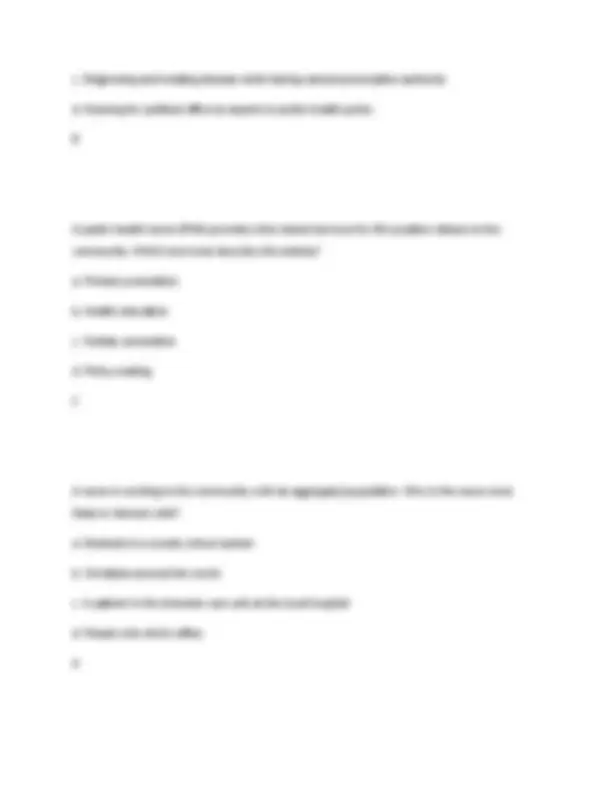
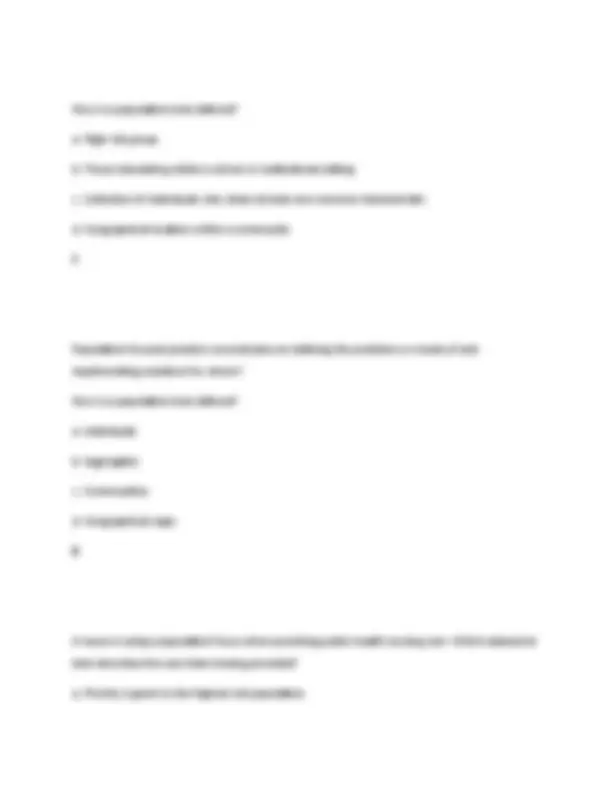
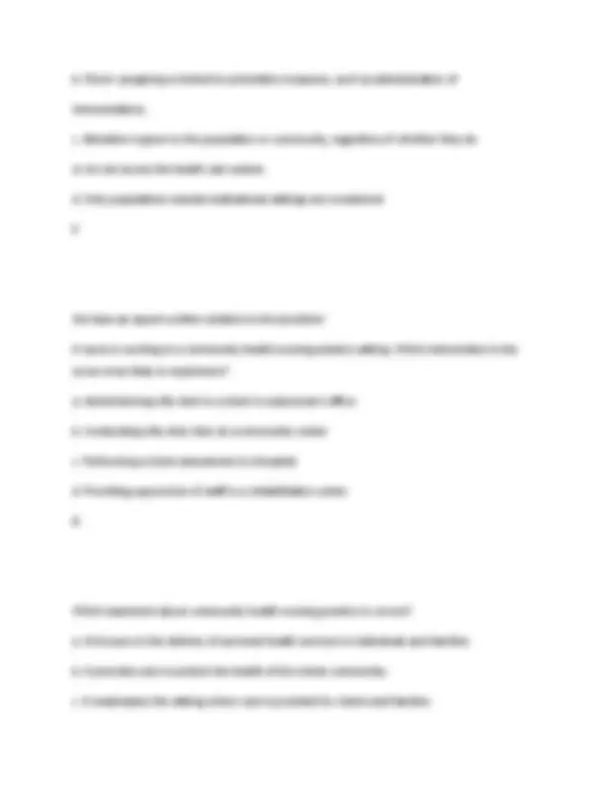
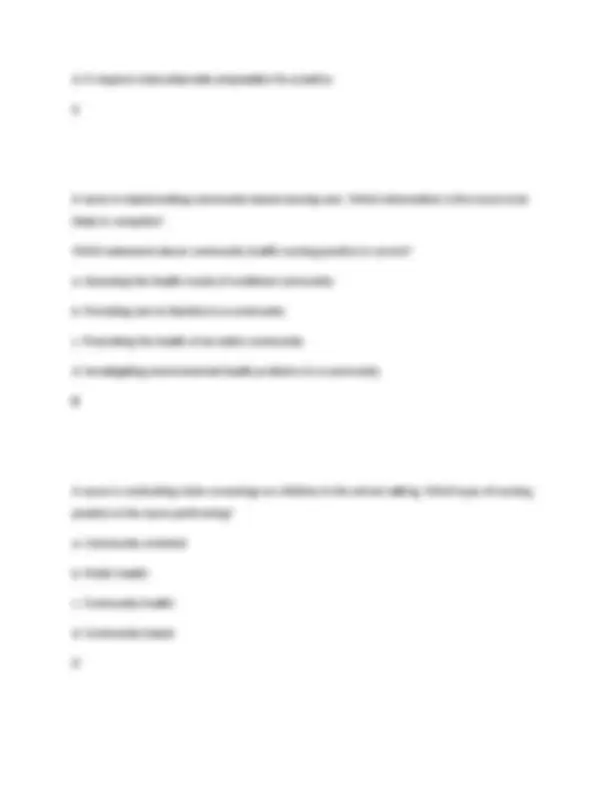
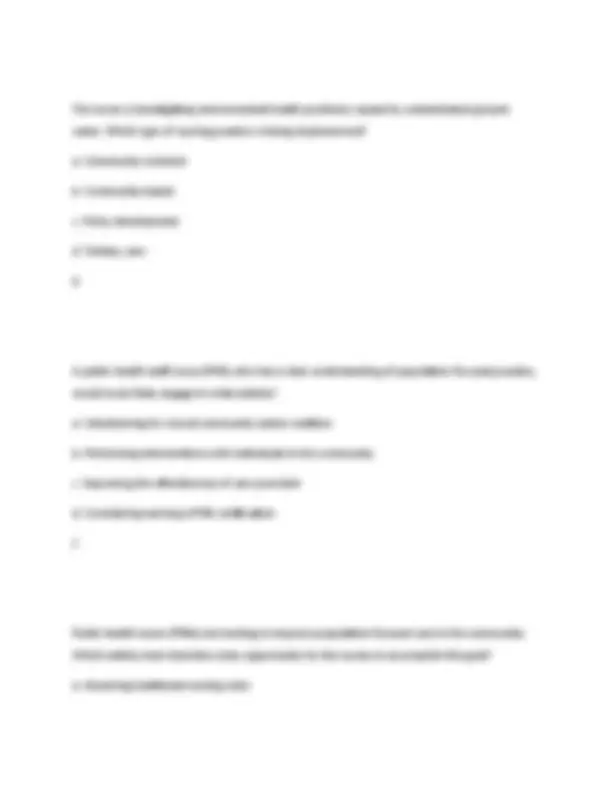
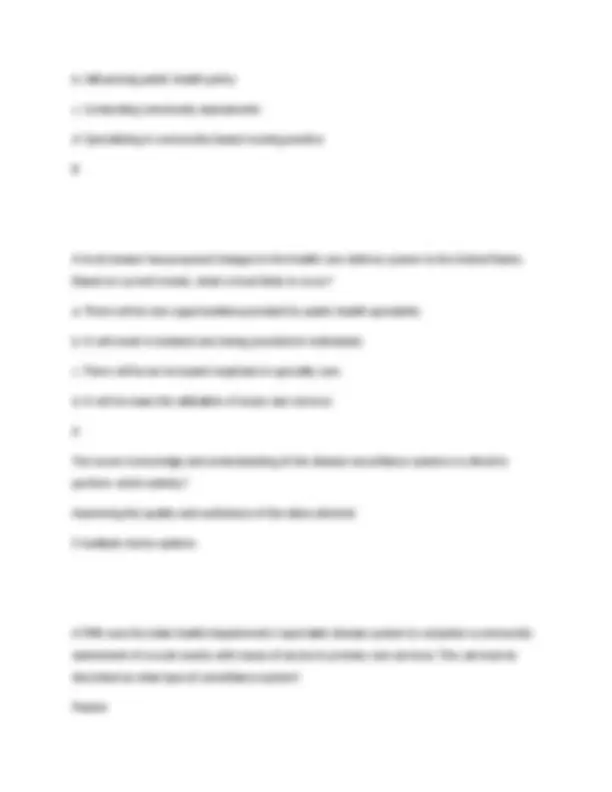
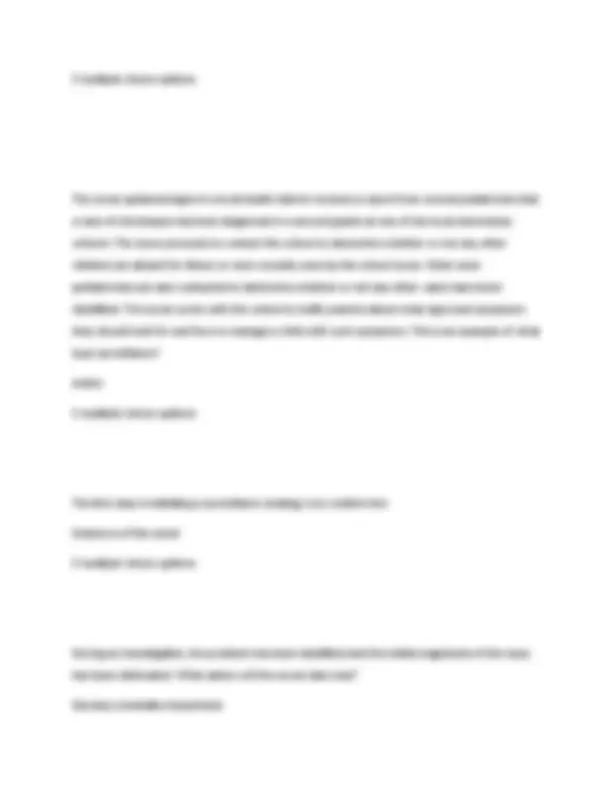
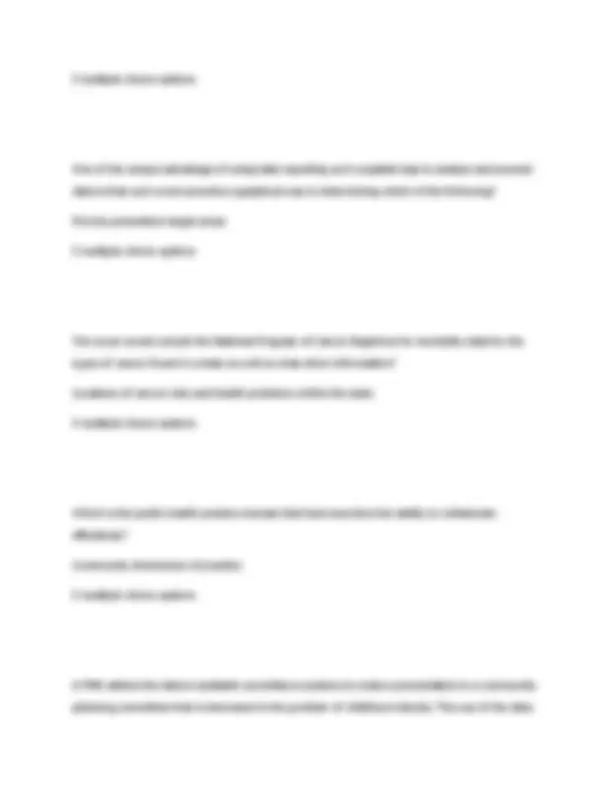
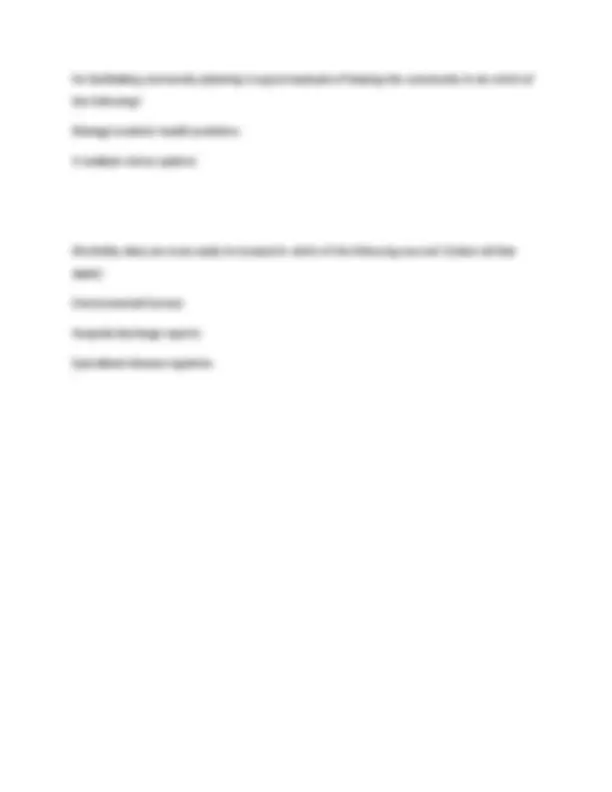


Study with the several resources on Docsity

Earn points by helping other students or get them with a premium plan


Prepare for your exams
Study with the several resources on Docsity

Earn points to download
Earn points by helping other students or get them with a premium plan
Community
Ask the community for help and clear up your study doubts
Discover the best universities in your country according to Docsity users
Free resources
Download our free guides on studying techniques, anxiety management strategies, and thesis advice from Docsity tutors
Stanhope: Public Health Nursing: Population- centered Health Care in the community 9th Edition Test Bank. GRADED A+ Community A group of people, often living in a defined geographical area, who may share a common culture, values and norms, and are arranged in a social structure according to relationships which the community has developed over time. aggregate This is a collection of individuals who have in common one or more personal or environmental characteristics. Change agent Nurses can act as content experts, helping communities select and attain task-related goals. In the example of infant malnutrition, the nurse can use epidemiological skills to determine the incidence and prevalence of malnutrition. The nurse can serve as a process expert by increasing the community's ability to document the problem rather than by providing help only as an expert in the area.
Typology: Exams
1 / 28

This page cannot be seen from the preview
Don't miss anything!





















Community A group of people, often living in a defined geographical area, who may share a common culture, values and norms, and are arranged in a social structure according to relationships which the community has developed over time. aggregate This is a collection of individuals who have in common one or more personal or environmental characteristics. Change agent Nurses can act as content experts, helping communities select and attain task-related goals. In the example of infant malnutrition, the nurse can use epidemiological skills to determine the incidence and prevalence of malnutrition. The nurse can serve as a process expert by increasing the community's ability to document the problem rather than by providing help only as an expert in the area.
change partner the nurse whose role is to act as an enabler-catalyst, teacher of problem-solving skills, and activist advocate with the client to create a positive outcome on the client's behalf. community assessment One of the core functions, which involves getting to know the community. It is a logical, systematic approach to identifying community needs, clarifying problems, and identifying community strengths and resources. community competence This is a process whereby the parts of a community—organizations, groups, and aggregates— "are able to collaborate effectively in identifying the problems and needs of the community; can achieve a working consensus on goals and priorities; can agree on ways and means to implement the agreed-on goals; and can collaborate effectively in the required actions" Community as a client Although the nurse may work with individuals, families or other interacting groups, aggregates, institutions, communities, or within a population, the resulting changes are intended to affect the whole community.
Community partnership When the lay community members have a vested interest in the success of efforts to improve the health of their community. Lay community members who are recognized as community leaders also possess credibility and skills that health professionals often lack. Community-focused nursing process: The phases of the nursing process that directly involve the community client as partner begin at the start of the contract or partnership and include assessment, diagnosis, planning, implementation, and evaluation. database Assessing community health requires the following three steps: 1. Gathering relevant existing data and generating missing data 2. Developing a composite database 3. Interpreting the composite database to identify community problems and strengths data collection to get usable information about the community and its health. The systematic collection of data about community health requires the following: • Gathering or compiling existing data • Generating missing data • Interpreting data • Identifying community health problems and community abilities
Process The view of community health as the process of effective community functioning or problem solving is well established. However, it is especially appropriate to nursing because it directs the study of community health to promote effective community action for health promotion. evaluation This begins in the planning phase, when goals and measurable objectives are established and goal-attaining activities are identified. After implementing the intervention, only the accomplishment of objectives and the effects of intervention activities have to be assessed. objectives These must be precise, behaviorally stated, and measurable and can be solved in a series of steps implemented over time rather than all at once. data gathering This is the process of obtaining existing, readily available data. The following data usually describe the demography of a community:• Age of the residents • Gender distribution of the residents • Socioeconomic characteristics • Racial distributions
the means by which objectives are met, are the strategies that clarify what must be done to achieve the objectives, the ways change will be effected, and the way the problem will be interpreted. Population-centered practice Although the nurse may work with individuals, families or other interacting groups, aggregates, institutions, communities, or within a population, the resulting changes are intended to affect the whole community. participant observation This is the deliberate sharing, if conditions permit, in the life of a community. For example, if the nurse lives in the community, activities such as participating in clinical organizations and church life and reading the newspaper. problem analysis Each problem identified as part of the assessment process must be put through a ranking process to determine its importance. problem prioritizing
Each problem identified as part of the assessment process must be put through a ranking process to determine its importance. secondary analysis This is when the nurse uses previously gathered data, such as minutes from community meetings. This type of analysis is extremely valuable because it saves time and effort. Many sources of data are readily available and useful for secondary analysis, including the following: • Public documents • Health surveys • Minutes from meetings • Statistical data • Health records setting for practice The community for the nurse practicing health promotion and disease prevention interventions with individuals, families, and groups. surveys Report data from a sample of persons that are necessary for identifying certain community problems. For example, a lack of accessible personal health services cannot be documented readily and accurately in any other way. target of practice
Nurses must be very careful to protect the identity of community members who provide sensitive or controversial data. In some cases the nurse may consider withholding data; in other situations the nurse may be legally required to disclose data. For example, nurses are required by law to report child abuse. Goals are generally broad statements of desired outcomes. Five methods of collecting data informant interviews, participant observation, secondary analysis of existing data, surveys, and windshield surveys. planning phase Analyzing the community health problems identified in the community nursing diagnoses • Establishing priorities among them • Establishing goals and objectives • Identifying intervention activities that will accomplish the objectives What is the primary focus to be addressed concerning the improvement of the health of the American people in the twenty-first century? a. Bioterrorism and global health threats
b. Delivery of individual care and hygiene c. The need for increased hospital and acute care d. Chronic disease and disability management A A community is concerned about the threat of bioterrorism. Which of the following best describes the basis for this concern? a. Bioterrorism has the potential to dissolve community-based programs. b. This threat could cause the health care system to collapse. c. The threat may divert funds from other public safety health care programs. d. Fear of bioterrorism will increase the need for shelters. C Which statement describes the consequence of the successful implementation of the Affordable Care Act? a. Americans will pay closer attention to their health status. b. Most of the population will be covered by health insurance. c. Public health departments will need to increase the number of nursing positions. d. The prevalence of obesity will decrease. B
A public health department makes sure that the essential community-oriented health services are available in the community. Which of the following core public health functions is being implemented? a. Policy development b. Assessment c. Assurance d. Scientific knowledge-based care C What is the purpose of public health core functions? a. Clarifying the role of the government in fulfilling the mission of public health b. Ensuring the safety of populations in receiving quality health care c. Providing community-based individualized care to every person in the United States d. Uniting public and private providers of care in a comprehensive approach to providing health care A Which of the following statements about public health is accurate? treatment than by public health approaches.
b. Expenditures and resources for public health have increased in recent years. c. Historically, gains in the health of populations have been related largely to changes in safety, sanitation, and food safety. d. Reform of the medical insurance system is the single change needed to improve the health of Americans. C A public health nurse (PHN) collects data and monitors the health status of the population. Which of the following core public health functions is the nurse addressing? a. Assessment b. Prevention c. Assurance d. Policy development A The public health nurse (PHN) compares the rate of teenage pregnancy in various areas of the city. Which of the core functions of public health is the nurse addressing? a. Assurance b. Assessment c. Prevention
The nurse manager makes sure that the staff members who work in a local clinic are competent in their job responsibilities. Which of the public health core functions is being demonstrated? a. Assurance b. Assessment c. Prevention d. Policy development A Which intervention is the nurse most likely to implement when addressing one of the primary goals of public health? a. Ensuring that a newly diagnosed 40-year-old hypertensive man takes his medication b. Finding home care for a 70-year-old client recuperating from a hip replacement c. Conducting an infant car seat safety check d. Contacting a local hospice to admit a terminally ill 60-year-old woman C We have an expert-written solution to this problem!
A community health nurse collects data about the number and proportion of persons aged 25 or older with less than a high school education. Which term best describes this type of data? a. Sociodemographic characteristics b. Health status data c. Health risk factors d. Health care resource consumption information A The public health nurse (PHN) analyzes data related to the number and type of United States Environmental Protection Agency air quality standards that a community failed to meet. This data is an example of using which community health profile indicator? a. Sociodemographic characteristics b. Health status c. Health risk factor d. Functional status C A nurse is implementing quality performance standards in a public health department. Which statement best describes the importance of this action? a. Quality performance standards are used to guide improvement in the public health system. b. Quality performance standards rigidly control public health.
Why is public health nursing considered a nursing specialty? has a distinct focus and scope of practice. requires a master's degree in nursing. is focused on disadvantaged citizens. performs interventions at the acute care level. A The necessary basic preparation for public health nursing is what level of nursing education? b. Baccalaureate degree c. Master's degree d. Doctor of Nursing Practice B A public health nurse (PHN) has been prepared at the graduate level. Which activity should the practitioner be able to complete? a. Teaching public and community health nursing b. Assessing and intervening successfully at the aggregate level
c. Diagnosing and treating disease while having earned prescriptive authority d. Running for political office as experts in public health policy B A public health nurse (PHN) provides clinic-based services for HIV-positive citizens in the community. Which term best describe this activity? a. Primary prevention b. Health education c. Tertiary prevention d. Policy making C A nurse is working in the community with an aggregate/population. Who is the nurse most likely to interact with? a. Students in a county school system b. Christians around the world c. A patient in the intensive care unit at the local hospital d. People who drink coffee A